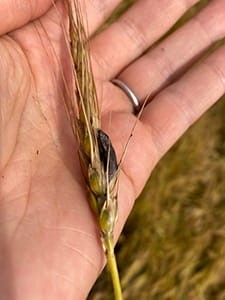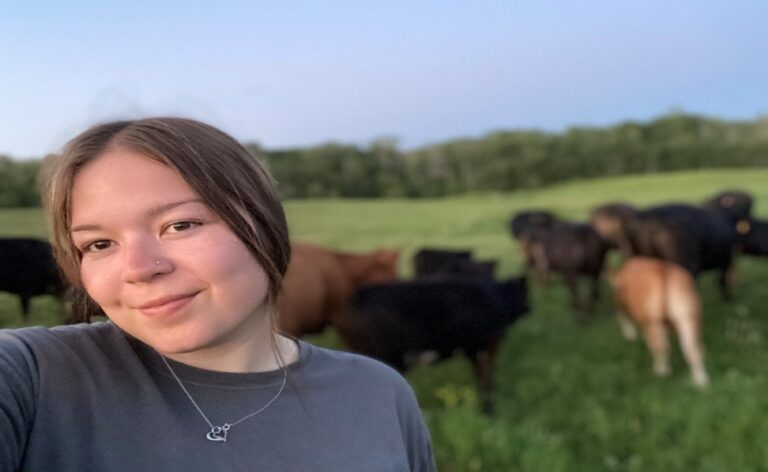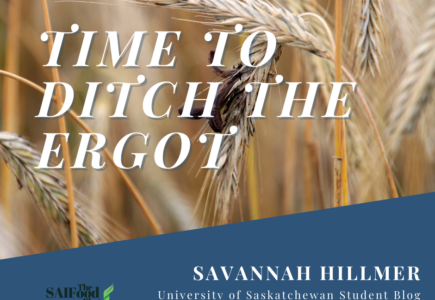By: Savannah Hillmer,
University of Saskatchewan student
For the past two summers, I have worked in Kamsack at one of the local ag retailers. Where I have had the privilege of going out to the field and job shadowing an agronomist. I have seen and learned firsthand about different crop diseases and pests. From my summer job experience and background on the farm, I have been interested in seeing why there is not a proper prevention policy put in place for the control and spread of ergot from ditch to crop. This past summer I seen a couple crops and heard about more with heavy infestations of ergot in the headlands. In my opinion there is an easy preventative solution of ditch mowing to help slow ergot infestations, therefore I wonder why there is not a preventative policy put in place for farmers. Considering ergot is hard to remove from seed and toxic there should be a solution of some sort put into place.
What is Ergot?
Claviceps purpurea or as others know it, ergot, is known to be a very harmful and toxic fungal infection that affects grasses and cereals. This infection if consumed by humans or livestock can lead to detrimental health problems. For example, ergotism is now rare in humans due to strict regulations but can be common in livestock. When ergot poisons livestock it can lead to lameness, gangrene, abortion, and eventually death. Humans’ health effects from ergotism are similar to animals. The infection in plants is easy to diagnose as they are very easy to see. They have a hard black to purple rind, and the inside is a white to-grey colour usually in place of the cereal grain. In grasses, they are sometimes much smaller; the ones that I have seen located in wheat crops are large and black taking place of the wheat kernel.

Ergot is known to be extremely toxic and can become a problem from flowering to the harvest of your crop. Ergot can only infect plants when they are flowering, hence the rapid spread in cereal crops. The easy spread of ergot is through insects, wind, and water splashes from ditch to field. If grains are detected to have ergot there exist some alternatives to destroying the crop. For example, seed cleaning is an option, but it would be difficult to have complete removal of the ergot from the grain. A farmer would have to test the ergot levels in their crop to know if it is possible to sell their infected grain as feed. Some mills will not accept or take in grain with Ergot levels above 0.04 to 0.06 percent (this would be about 4-6 infected kernels per 1 litre of grain). Farmers need to be knowledgeable about ergot so that we can have methods that prevent the initial spread.
No Policy put Into Place for Prevention … Should there be?
Unfortunately, ergot can spread from ditches to fields, unless ditch grass growth is managed. It is manageable if a plan is made early enough to prevent the pathogen from spreading. That is why I think that it is important that there is a policy or rule to be put into place about mowing our rural ditches. From what I can find there are no dates (for mowing) that are early enough across the province to prevent ergot. It would be beneficial to our crops if ditches were mowed before our cereal crops start flowering to prevent the spread.
Right now the dates for mowing ditches across Saskatchewan are from June to October, although normal ditch mowing takes place from mid-July to mid-October. The earliest mowed ditches are the ones along primary roads and secondary highways. These dates are all already too late to control the spread of ergot. The dates for ditch mowing give room for livestock owners and farmers to cut hay prior to the start of mowing. In turn, these salvage the wasted grass and help the livestock industry. This is a trade-off in the ag sector that has not been utilized as it should be in different areas of the province where ergot is becoming a problem. Farmers should have the right to have their ditches mowed to prevent ergot and potentially harmful diseases from their crops.
Recommendation
Although there are no rules, regulations, or policies on the Government of Saskatchewan’s website, they have a page that includes different ways to manage the infection. So, taking the precautionary steps to help prevent it is necessary. A very important prevention measure for all crops is sanitation; if we mow around headlands or roadways before the grasses in the ditch and our crops flower, it can prevent the infection.
Destroying the host before it can get to our crops seems to be the most ideal management practice. That is why it would be in the farmers, producers, and consumers best interest to implement a plan or regulation to stop the spread of Ergot to the best of our ability.
- Beware of Ergot in Grasses and Grains This Year. (n.d.). Government of Saskatchewan. Retrieved October 12, 2022, from https://www.saskatchewan.ca/business/agriculture-natural-resources-and-industry/agribusiness-farmers-and-ranchers/sask-ag-now/livestock-and-feed/beware-of-ergot-in-grasses-and-grains-this-year
- Ergot infestations high in cereals | the western producer. (n.d.). Retrieved October 13, 2022, from https://www.producer.com/news/ergot-infestations-high-in-cereals/
- Ergot of Cereals and Grasses | Disease. (n.d.). Government of Saskatchewan. Retrieved October 12, 2022, from https://www.saskatchewan.ca/business/agriculture-natural-resources-and-industry/agribusiness-farmers-and-ranchers/crops-and-irrigation/disease/ergot-of-cereals-and-grasses
- Hay Salvage and Ditch Mowing | Livestock Programs. (n.d.). Government of Saskatchewan. Retrieved October 12, 2022, from https://www.saskatchewan.ca/business/agriculture-natural-resources-and-industry/agribusiness-farmers-and-ranchers/programs-and-services/livestock-programs/ditch-mowing-and-hay-salvage
- Ergot of Cereals and Grasses | Disease | Government of Saskatchewan. (2014). Government of Saskatchewan. Retrieved January 4, 2023, from https://www.saskatchewan.ca/business/agriculture-natural-resources-and-industry/agribusiness-farmers-and-ranchers/crops-and-irrigation/disease/ergot-of-cereals-and-grasses
- Ergot poisoning. Canadian Cattlemen. (2013) Retrieved January 4, 2023, from https://www.canadiancattlemen.ca/vet-advice/ergot-poisoning-2/#:~:text=Some%20feed%20mills%20will%20not
- Seeing Increased Ergot Levels? (n.d.). Government of Saskatchewan. Retrieved October 12, 2022, from https://www.saskatchewan.ca/business/agriculture-natural-resources-and-industry/agribusiness-farmers-and-ranchers/sask-ag-now/crops/crops-blog-posts/seeing-increased-ergot-levels
Savannah Hillmer

Hi, my name is Savannah Hillmer. I grew up on a mixed cattle and grain operation in Fort Assiniboine, Alberta until we moved in 2016-17 to a new farm near Benito, Manitoba that borders Saskatchewan. Here I have expanded my herd within the farm by participating in 4-H clubs in both Alberta and Manitoba. I am now in my third year in the College of Agriculture and Bioresources at the University of Saskatchewan majoring in Ag Business and minoring in Field Crop Production. I find that growing up on the farm has had a large positive impact on my life and guided me to where I am now. I enjoy, raising livestock, grain farming, and all the things rural Saskatchewan and Manitoba has to offer.


